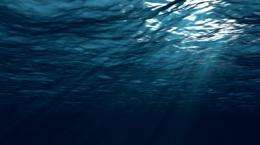April 22, 2015 report
Ship ballast dumps around Australia climbing increasing risk of invasive species getting foothold

(Phys.org)—A small team of math and biological researchers with the University of Adelaide, has found that the amount of ballast water being dumped into the waters around Australia more than doubled over a thirteen year study period increasing the possibly of invasive species introduction. In their paper published in Royal Society Open Science, the team describes how they studied historic ballast data to create a model of ballast dumping, and discovered that most of the increase can be attributed to mining operations.
When big ships unload their cargo, they are left mostly empty, which creates a weight distribution problem—to fix that problem, giant pumps are used to fill ballast tanks with water from the sea in which they reside. Unfortunately, those pumps also suck up local organisms, which then live in the ballast tanks for some period of time as the ship travels to a place to pick up cargo. Upon arrival, the water in the ballast tanks is pumped back into the sea in anticipation of new added cargo. But, as scientists, environmentalists, sports enthusiasts and others have found, that ballast water may contain an organism that is able to take up residence (dubbed an invasive species) in its new part of the world, and sometimes is able to dominate those already there, putting the legacy residents at risk. In this new effort, the researchers sought to put some metrics on the ballast tank dumping problem around the shores of their native Australia in an attempt to better understand the invasive species risk for the country. They gathered historical shipping data for the period 1999 to 2012, which included ballast filling and dumping information and data regarding organisms that are known to be able to survive living in ballast tanks.
In analyzing their data using a computer model, they found that ballast dumping in Australian seaports more than doubled during the study period and that the majority of the increase was related to mining and forestry operations, which meant that the dumping increase was more often located in remote ports near mines, rather than in more established areas. They also found that a large percentage of ballast water was coming from the waters around Southeast Asia and China, which they suggest offers an opportunity for more research regarding which species from those areas might be in the ballast water being dumped in Australian ports and other places around the world.
More information: Temporal modelling of ballast water discharge and ship-mediated invasion risk to Australia, DOI: 10.1098/rsos.150039
Abstract
Biological invasions have the potential to cause extensive ecological and economic damage. Maritime trade facilitates biological invasions by transferring species in ballast water, and on ships' hulls. With volumes of maritime trade increasing globally, efforts to prevent these biological invasions are of significant importance. Both the International Maritime Organization and the Australian government have developed policy seeking to reduce the risk of these invasions. In this study, we constructed models for the transfer of ballast water into Australian waters, based on historic ballast survey data. We used these models to hindcast ballast water discharge over all vessels that arrived in Australian waters between 1999 and 2012. We used models for propagule survival to compare the risk of ballast-mediated propagule transport between ecoregions. We found that total annual ballast discharge volume into Australia more than doubled over the study period, with the vast majority of ballast water discharge and propagule pressure associated with bulk carrier traffic. As such, the ecoregions suffering the greatest risk are those associated with the export of mining commodities. As global marine trade continues to increase, effective monitoring and biosecurity policy will remain necessary to combat the risk of future marine invasion events.
Journal information: Royal Society Open Science
© 2015 Phys.org















